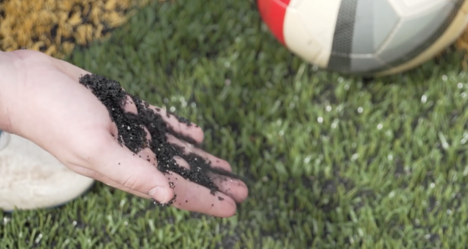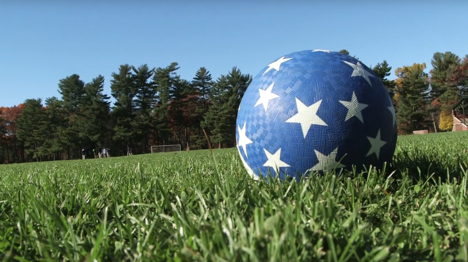Frequently Asked Questions
We answer some of the questions we've received most frequently about artificial turf and safer alternatives:
Artificial Turf
1. What are the concerns about chemicals found in artificial turf infill made with tire crumb?
2. Do you have information about PFAS in artificial turf?
3. What is known about other infills, such as those made with TPE, EPDM or and plant-based materials?
4. Do you have information about other topics, such as heat, environmental concerns or injury rates?
Safer Options: Organic Grass Playing Fields
6. How much play time can you get on organically managed grass?
8. How much does it cost to maintain an organically managed grass athletic field annually?
Other Questions
11. Do you have information about playground surfacing?
12. Can you send me hard copies of your materials?
______________________________________________________________________
1. What are the concerns about chemicals found in artificial turf infill made with tire crumb?
A large number of chemicals are found in tire crumb. Many of these have adverse effects on human health or the environment. Some of the chemicals found in tire crumb are endocrine disrupters (e.g., phthalate esters); some are known or suspected carcinogens (e.g., arsenic, cadmium, benzene, styrene); and some are associated with other human health effects. For example, polycyclic aromatic hydrocarbons (PAHs) in tire crumb infills are a particular concern due to carcinogenicity. As of August 2022, eight PAHs in tire crumb infills will be subject to new limits in the European Union.
Children are uniquely vulnerable to the effects of toxic chemicals because their organ systems are developing rapidly and their detoxification mechanisms are immature, among other factors. For these reasons, it is particularly important to make careful choices about children’s exposures. For more details:
- See the “Tire Crumb” section (page 4) of the TURI report “Athletic Playing Fields: Choosing Safer Options for Health and Environment.”
- See TURI’s detailed document on tire crumb.
- Watch this video to hear from public health expert Dr. Richard Clapp.
2. Do you have information about PFAS in artificial turf?
We have created a fact sheet that provides some basic background information on PFAS and on testing methods used to detect these chemicals in artificial turf. Also see a detailed fact sheet from the Cancer Free Economy Network.
3. What is known about other infills such as those made with TPE, EPDM, or and plant-based materials?
While vendors do offer alternative infills, many of these materials have not been studied fully. Other infills on the market may be made with rubber, plastic, mineral-based, or plant-derived materials. When researching turf options, communities should evaluate materials carefully and may wish to require additional testing to ensure they have considered the full range of chemicals.
See pages 5 through 9 of the report "Athletic Playing Fields: Choosing Safer Options for Health and Environment" for a thorough description of a number of alternative infills.
See a more detailed overview of infills, as well as detailed information on TPE and EPDM, in TURI’s infill assessment documents.
4. Do you have information about other topics, such as heat, environmental concerns, snow removal, or injury rates?
Use of artificial turf presents a number of issues other than human health concerns related to chemical hazards. Refer to pages 11 through 13 of the report "Athletic Playing Fields: Choosing Safer Options for Health and Environment" and the Physical Hazards document for more details on the topics described below.
Heat: In sunny, warm weather, artificial turf can become much hotter than natural grass, raising concerns related to heat stress for athletes playing on the fields. Some towns, such as Burlington, MA, have adopted policies to protect athletes from high temperatures. For more information on approaches to determining safe temperatures on play surfaces, see page 2 of our artificial turf fact sheet.
Environmental concerns: Environmental concerns include loss of wildlife habitat and contaminated runoff into the environment. Another environmental concern is migration of synthetic particles, including infill and plastic grass blades, into the surrounding environment. In 2020, reuse of turf in a construction project led to the release of a large quantity of crumb rubber into the Puyallup River in Washington State. Recent findings indicate that a chemical found in tires is responsible for mortality of coho salmon in the Pacific Northwest.
Snow removal: Manufacturers recommend using specialized equipment for removing snow for winter play, such as snow blowers designed for turf fields. One Massachusetts town estimated the cost for snow blowing the field would be $5,000- $10,000 per snow storm. Damage caused to a field during snow removal could impact the warranty of the field. Snow removal may also remove infills or fibers from the field, moving them into the environment. Local conservation regulations may restrict snow removal from fields depending on proximity to wetlands, waterways, or other protected lands.
Disposal: Artificial turf fields are typically replaced every 8-10 years. Some synthetic materials may be reusable or recyclable, though recycling options are often limited. Others may have to be disposed of in a landfill or through incineration when the field is due for replacement. Challenges related to disposal are discussed in The Seattle Times, The Atlantic, Environmental Health News, and Zembla.
Injuries: One particular concern is increased rates of turf burns (skin abrasions) associated with playing on artificial turf. These abrasions are a risk factor for serious bacterial infections.
5. Have communities in Massachusetts had success building athletic fields using organically managed grass?
By using organic grass, communities eliminate the use of toxic insecticides, herbicides and fungicides. Organically maintained grass will also eliminate many of the health concerns found in artificial turf.
Communities such as Springfield, Marblehead and Martha’s Vineyard, all in Massachusetts, have improved their field quality through organic management of their athletic fields.
- Be sure to read our case studies about Springfield, Marblehead, and Martha's Vineyard.
- Refer to page 16 of the report “Athletic Playing Fields: Choosing Safer Options for Health and Environment.”
- View our video highlighting the organically managed athletic fields in Springfield.
- View our video highlighting the successes of three MA communities using organic maintenance on their athletic fields.
- View the video that features Chip Osborne, an expert in organic grass care.
- Check out The Field Fund’s informative website on how to implement organic grass fields.
6. How much play time can you get on organically managed grass?
Many parents, athletic directors and town administrators have contacted us with this question. According to organic grass athletic field experts, the key to a well-functioning field is healthy soil and a healthy grass root system. Individual fields can be diagnosed and maintained in a way that addresses specific issues and performance needs.
Take a look at the Springfield case study to find the number of hours played at three organically managed grass fields. If you want to estimate the number of playable hours on a soccer field in your community, you can use Treetop Park, the full-sized soccer field, as an example. Treetop Park is used for approximately 1,050 hours of practice, games, and informal activity annually.
We’ve also documented playing time on fields in the Marblehead case study. The town has maintained high quality, organically managed grass fields for more than 15 years. In the case study, you’ll find hours of use per week for four town fields, which are used for field hockey, baseball, lacrosse, soccer and more.
If you want to estimate the number of playable hours on a football field in your community, you can use Hopkins Field, the full-sized football field, as an example. This field was used for multiple sports and recreational activities for a total of 1,860 hours in 2018.
You can also view hours of use in our Martha's Vineyard case study.
7. Do organically managed natural grass fields need to have scheduled “rest” times? Do games need to be canceled for rain?
No. Springfield, Marblehead, and Martha's Vineyard do not rest their fields and do not restrict play during particular seasons or rotate fields. When drainage is designed appropriately and soil is properly aerated and maintained, the soil is able to hold more rainwater, reducing puddling after rain.
Springfield does not cancel field use for rain. Marblehead does have a “red flag” policy for times when the ground is saturated with rainwater after a full day of hard rain. Field puddling can be an issue on the clay used on softball and baseball infields, however this is unrelated to use of grass in the other sections of the fields.
8. How much does it cost to maintain an organically managed grass athletic field annually?
Many communities have questions about costs associated with annual maintenance of organically managed fields. See our case studies to review annual maintenance cost figures for organically maintained fields in several communities. When the full product life cycle is taken into account, natural grass is likely to be more cost effective than artificial turf. Organic management of natural grass builds healthy soil and a robust root system, which can further lower costs over time.
- See Page 18 of the report "Athletic Playing Fields: Choosing Safer Options for Health and Environment" in section “Installation/Maintenance Costs: Comparing Artificial Turf with Natural Grass.”
- See our Cost analysis of natural grass compared with artificial turf
9. How can I learn more about organically managed natural grass fields? How can my field be improved with organic maintenance?
We have compiled information from athletic field landscaping professionals, as well as lessons learned by individual communities that are successfully maintaining their athletic fields with organic practices into a fact sheet to help communities learn how to transition to organic grass management.
Our case studies feature the successes, costs, and functionality of organically maintained grass playing fields:
- Martha's Vineyard case study
- Springfield case study
- Marblehead case study
- Southwest Pennsylvania case study
Here are a few external resources for you to learn more about organically managed grass playing fields, and communities that are using them:
- The Field Fund- offers both supplemental maintenance and renovations of playing fields, and training, with the goal of improving the quality of recreational spaces in Martha's Vineyard
- Midwest Grows Green- initiative of the Integrate Pest Management institute, focused on sharing pesticide and fertilizer reduction information
- Grassroots Environmental Education- a New York-based educational non-profit organization, focused on educating the public about the links between common environmental exposures and human health
For personalized help with grass field issues, or converting a field to organic management, a consultant can be a helpful resource. Below are a few that specialize in organic athletic fields and work in Massachusetts. Note that TURI does not endorse any specific provider.
10. Are there regulations that govern athletic field construction near wellhead protection zones in Massachusetts?
Several Massachusetts communities have made decisions about athletic field surfacing based on wellhead zoning. They were able to receive guidance from regional MassDEP representatives. For up to date information, contact MassDEP. For information on Zone 1 wellhead protection zones, visit MassDEP's website.
11. Do you have information about playground surfacing?
Yes, we do. We have researched a number of playground surfacing options on the market, including those made with tire crumb. Download our Playground Surfacing report.
12. Can you send me hard copies of your materials?
Yes! Follow this link to send us your questions and requests.

